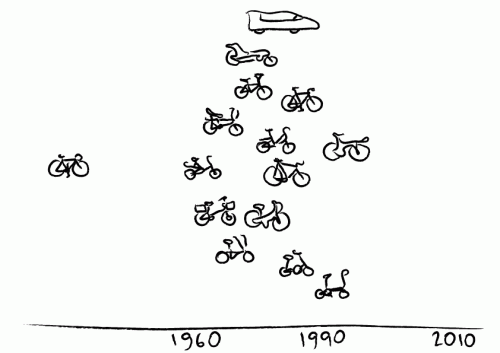
100 years of slate-itude
The silhouette of mobile devices has firmly homogenised around the anonymous rectangle. Our fond memories of clamshells, spring-loaded sliders and rotary lipstick mobiles are starting to fade. Will there ever be a time when we can get excited mobile form factors again? Or is it better that we’ve focused attention on a single form for now? What barriers need to be removed before we are likely to see widespread form divergence?
Before we explore these questions, I want to talk about bikes.
When bikes were invented, there were all kinds of different configurations of wheels and mechanisms, different shapes of frames and so on. Then after a while, bike design settled on the two wheeled diamond frame that is so familiar today. For about 60 years this was the dominant form for bikes, with a few incremental improvements to weight and manufacturing cost. Then suddenly in the 1960s, as you can see in my sketches below, there was this explosion of new specialised bike forms, from the BMX to the Brompton to the chopper.
Yes, I’m saying that the current rectangular smartphones are like the classic diamond framed bike. Before the surge of smartphones in 2007 it was possible to deliver beautiful, crazy, divergent shapes that delivered adequate speech and texting, like a penny-farthing is adequate as a bike. But in order to provide richer visual interaction, the screen had to grow and grow until the device effectively became a picture frame for a digital experience. Since then, alternative form factors struggled to compete because they weren’t able to deliver a similar level of visual performance. Form and functionality are intrinsically linked.
On the plus side, by focusing technological development on one form factor, we are seeing constant incremental improvements to slate devices. Bigger, better screens display faster, more responsive graphics. Manufacturing and material advancements create tougher, more attractive casing or offer additional interactive surfaces on devices. New forms and extended functionality are made possible through accessories like Nike’s Fuelband that use the phone as a platform to provide processor power and connectivity. This evolution is making it increasingly difficult for any other form factor to compete one-to-one with the slate. But should it have to?
The slate is the perfect compromise if it is your only phone, but what if you were able to choose from a selection of devices, depending on the moment? Thanks to a Skype login, an Apple ID or Google Voice in the US, the phone number and SIM no longer need to be the main focus of a device’s identity. If this was the case you could just pick up your iWatch, Google Glasses or tough-phone when you need them to be your dominant device and all your information and contacts would be synced. Taking this idea further, we could even see a disappearance of form altogether, with devices embedded in clothing or environments.
The kind of mass divergence we saw happen with bike forms occurred because of a democratic marketplace in which consumers could choose a bike that fit their lifestyles. Phones are a bit more technologically complex than bikes, but I believe that enabling seamless switching between multiple devices would completely shift the barriers for device design. Different subcategories wouldn’t compete with each other. Phones could be sold based on merit and not on subsidy and then finally we could get ourselves that BMX or Chopper or refurbished penny farthing we always wanted.
These issues are at the heart of MEX Pathway #6, entitled ‘Excite users with change in shapes, materials or the abandonment of physical form’ and will be explored at the next MEX in London on 26th – 27th March 2013. Some of the questions to be considered include:
- Is the rectangular slate the endpoint of mobile device design?
- Which methods are available for imagining and testing new forms?
- Which barriers are restricting more varied form factors? What would happen if they were removed?
- Which materials, technologies and manufacturing processes are emerging to reshape the form of mobile devices in the future?
- Will there be a time when form disappears?
Think this is a bonkers analogy? Keen to make this happen, but need help from a big picture strategist? Get in touch with Andrew on twitter or email.




[…] published new essays: Andrew Muir Wood has written ‘100 years of slate-itude‘ on form factor innovation and ‘A failure of insight?‘ on user research […]
[…] generic touchscreen slates or traditional laptops (read Andrew Muir Wood’s 2013 essay ‘100 years of slate-itude‘ or browse the wider category of Pathway #6, Thinking Outside the Slate, in the MEX […]